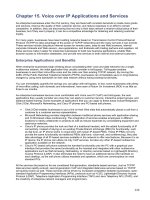IP Services
Bạn đang xem bản rút gọn của tài liệu. Xem và tải ngay bản đầy đủ của tài liệu tại đây (27.1 KB, 2 trang )
IP Services
When we talk about IP services, we refer to the applications, protocols, and services that
not only use IP themselves, but also provide data to be used by other IP protocols. These
IP services typically allow for IP communications between hosts by performing functions
such as physical address resolution, automatic address assignment, name resolution, and
time synchronization.
Address Resolution Protocol (ARP) is an IP service that was developed to map physical
addresses to logical addresses. This resolution is required because hosts need to be able to
physically address the data frames at Layer 2 to the appropriate destination. In most
cases, the hosts only know each other by IP address. Consequently, ARP functions by
broadcasting on the local subnet for the host that has the IP address that needs to be
resolved. Because it is a broadcast, all hosts will process the packet, but only the host that
actually has that IP address will respond with its MAC address, thereby allowing the
original source to properly address the packet both logically by IP address and physically
by MAC address.
DHCP exists to provide unconfigured hosts on a network with the appropriate IP
addressing information necessary to enable them to communicate on the network.
Because a host that is a DHCP client does not have an IP address to use, DHCP uses
broadcasts between the DHCP client and the DHCP server. When a DHCP client is
turned on, it issues a broadcast known as a DHCP Discover packet. The objective of this
broadcast is to discover whether there is a DHCP server on the network. If there is, the
DHCP server responds with a broadcast known as a DHCP Offer packet, because the
client still has no IP address. Because the packet is a broadcast, the client still processes it
even though the client has no configured IP address. If the network has multiple DHCP
servers, they all respond with a DHCP Offer, and the client accepts the first offer it
receives. The client then broadcasts a packet known as a DHCP Request packet. This
serves two purposes. First, it notifies the selected DHCP server that the client has elected
to accept the DHCP Offer. Second, it notifies all other DHCP servers that the client
selected another DHCP server, allowing them to place that offered IP address back in the
pool of IP addresses they can offer to clients. Finally, the DHCP server responds with a
final broadcast known a DHCP Acknowledgement packet, which notifies the client that it
can use the IP address that it was offered and provides additional configuration
information such as subnet mask, default gateway, name servers, and so on. At this point,
the client configures itself accordingly and can begin engaging in full TCP/IP
communications.
DNS provides for the resolution of host names and fully qualified domain names to IP
addresses. The reason for this is simple. Most humans do not know the IP address of the
remote hosts that they are trying to communicate with. They know the name, such as
www.cisco.com
. Unfortunately, the network hosts require the IP address of the remote
host to communicate with that host. When an IP host receives a request to communicate
with a remote host by name, the host automatically and transparently contacts a DNS
server to resolve the name to an IP address, which if successful allows the two hosts to
communicate with each other. A detailed discussion of DNS is beyond the scope of this
book, but an excellent resource for understanding DNS is DNS and BIND, Fourth
Edition, by Paul Albitz and Cricket Liu.
Network Time Protocol (NTP) is used to synchronize the time across hosts over the
network. Time synchronization is critical for applications such as Windows
authentication, Kerberos, IPsec, as well as event logging. NTP functions over UDP port
123 and allows clients to synchronize their time with a master time server, known as a
stratum 1 or stratum 2 server.









